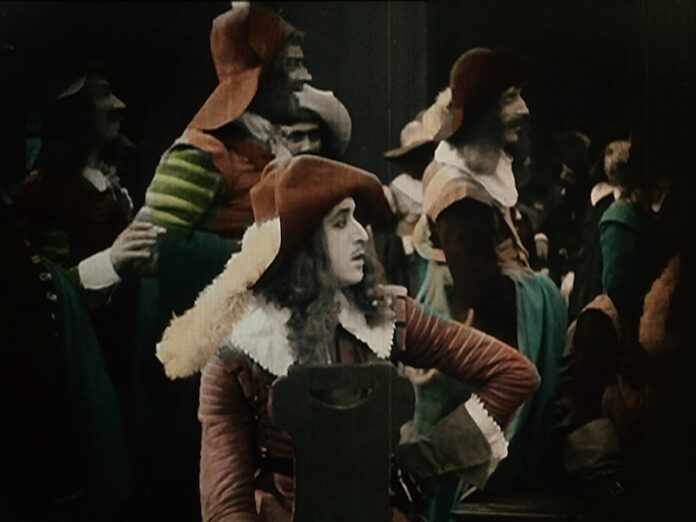The Giornate dawned with grey skies but good times, a respite from Storm Amy and all the rest of the week’s turbulence, a day of pretty views and outbreaks escapism. Many of us were just grateful to be get here, let alone arrive on time, after the transport situation was especially complex this year. It was an especially mellow start to the festival for me. Blame it on the 3am alarm call, the cold medication or just the pleasurable daze of seeing so many familiar faces all at once. Will I sneeze or snooze my way through the first day of films? Who knows? And will my ears ever “unpop” from the plane? Join me now to find out.
With little fuss, as the market closed, the festival opened with a series of picturesque views of Liguria in the early cinema strand. Those Ligurian views, accompanied delicately by Gunter Buchwald, washed over me in the best way possible, picturesque harbour followed by glistening sunset, by japes on the beach. At times these travelogue programmes border on kitsch, early 20th-century Instagram, everyone replicating the same flattering angles of the coast, a young girl poses herself as she arranges flowers. But then, the faces turn straight to the camera, figures in the background animate like a living Lowry or an antique stone edifice of fishermen’s homes, piled higgle upon piggle. Something strikes you suddenly with the inevitable collapse of the past then, the past now, and the present now. Then you feel blessed that once upon a time in 1925 someone thought to crank a handle and now we get to see all this beauty, all this vivid human existence, several metres high, in a beam of light – when it could have passed and gone for ever. It’s astonishing, right? Or maybe the cold medication is kicking in.
Lest we forget, we are all hurtling towards an unknown future, but I happen to know that at least one musician was fighting the transport delays to race towards purgatory, and weren’t we grateful for it? Two fragments of Italian Dante adaptations from 1911 gave us scenic views of purgatory, despite the naked writhing bodies and a rather impressively menacing snake. Thanks to Daan van den Hurk and Frank Bockius for being our guides through the murk.
Mixed feelings accompanied the children’s portion of the afternoon bill, devoted to the joys of summer camp. We saw Italian boys and girls taking the air, playing games, holding balloons, and saluting (lots of saluting) in the mountains in Colonia Alpina, which was very striking amateur footage shot by industrialist Emilio Gallo in 1924-9. The feature film was a Ukrainian romp called Troye/The Three (Oleksandr Solovyov, 1928), which was about three boys from three different socioeconiomic backgrounds joining a pioneer camp in the Crimea. While there was a comic kidnapping plot, this too, was best in playful mode, enjoying the antics of the kiddies and their families, and poking fun at the same. Although, we cannot condone such cat cruelty as we saw in one family, we appreciate there are perhaps other battles to fight. A very good-looking film, with cinematography by Albert Kuhn and production design by Konstantin Yevseyev. Donald Sosin brought out the brightness, and the dark, in both of these films.
Which of the seven dwarfs got the better of me this night. Well… don’t mention the nose! Tonight’s main event, accompanied by the Orchestra da Camera di Pordenone, conducted by Ben Palmer, playing a lushly romantic score by Kurt Kuenne, was Augusto Genina’s sumptuous stencil-tinted Cirano Di Bergerac (1922-3). Thanks to Jay Weissberg for the pronunciation lesson on this one. I would have loved to stay right to the end of this one, but that wouldn’t have been wise, Doc. True to the source, this film seems to have been a labour of love for Genina, who was assisted by his cousin Mario Camerini, and finished the film late due to the complexities of those vibrant colours, which provide a lurid decadence, a flourish that truly suits the tale, and its hero. Pierre Magnier, plus prosthetic, makes for a dashing Cirano. He’s maybe best known now for his role in Renoir’s La Règle du Jeu (1939), though in my house, also for that 1900 Hamlet duel with Sarah Bernhardt. It’s a beautiful film about men, and a country, torn apart by love and war, with only cleverness, and passion, to protect them.
This deathless romantic comedy of soft hearts and sharp wits was preceded by two of just the kind of snippets we are grateful to see on the big screen here at the Giornate – the gloriously violent Max Fleischer cartoon Boxing Kangaroo (1920), and a rarer treat, full-colour, home-movie footage of a sprightly Chaplin dancing and prancing and chomping on flowers in his garden in 1957. He looks like a grey-haired man, but moves like he has just spun out of Fleischer’s inkwell. Amazing grace. And good to hear there will be more to come, this week, with contributions from David Robinson also.
How many dwarfs did I embody today? Well, Sneezy, Sleepy, Dopey … and Happy. Welcome home, Pordenauts.
Intertitle of the Day
“Because of that rascal child of yours, the cats have gone wild.” – Well that is what will happen when you do things with a clothes peg that would make even Koko the Clown wince, in The Three.



